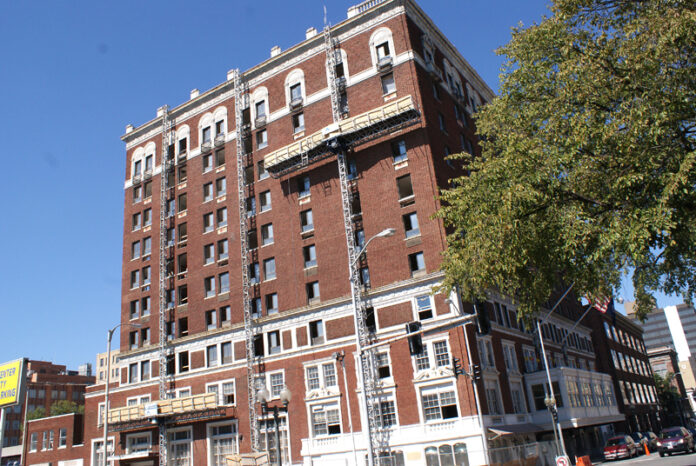
The Roanoke Valley Preservation Foundation has announced awards for six buildings, an environmental community and a book, as well as a “Bulldozer Award” to Carilion Clinic for demolishing the Carlton Terrace-Reid Building. They were announced at the Foundation’s annual meeting at the Patrick Henry on Tuesday.
Annual preservation awards are presented to raise public awareness of the value of restoring and reusing older structures and to encourage stewardship and to recognize the work of individual efforts. The eight award recipients this year include Big Lick Junction/ Community School—adaptive reuse; Meridium—commercial rehabilitation; Catawba sustainable community—environmental stewardship; Patrick Henry Hotel—adaptive reuse; City Market Building–restoration; Salem Historical Society Museum—environmentally and historically sensitive addition; the Gazebo in Lake Spring Park in Salem—reconstruction and a book on the Deyerle family builders by Michael Pulice—cultural resource.
The Patrick Henry Hotel, the Catawba Community (formerly Virginia Tech-Catawba Hospital farm) and the Carlton Terrace-Reed Building had been listed previously as endangered sites. Big Lick Junction, built in 1925, was a three-story dry goods distribution warehouse originally operated by the Goria brothers at the corner of Campbell Avenue and Second Street, SE. The Community High School of Arts and Sciences is on the first floor and a music and film department is in the basement. Upper levels were renovated for 15 studio and one-bedroom apartments.
Meridium, a world-class software company, is in a four-story, renovated warehouse at 207 Bullitt Ave., SE. Bonz Hart, the founder, started the company in his garage in Goodview in Bedford County in 1993 and it has blossomed into a firm employing 130 in Roanoke and almost that many more in places like Dubai, Malta, South Africa, Australia and India. Hart put a new face on an old building formerly occupied by Mostly Sofas and American Chemical Co. The $5 million renovation of the building, now painted brick red, includes exposed heavy timber framing and refurbishing wood floors on the interior.
Catawba Sustainability Center, an umbrella organization in Virginia Tech’s Outreach and International Affairs Department, is using the former dairy farm of almost 400 acres for a variety of environmental practices. The farm, with twin silos and a big barn in the heart of Catawba Valley, is the research site for Virginia Tech faculty and students to work with local farmers on water quality and quantity, energy, reduction in greenhouse emissions, food security and job creation issues.
Christy Gabbard, center director, worked with Catawba Landcare, a community group seeking to preserve the unused farm and its deteriorating buildings. Current projects showcase innovative land management practices and support new and expanding agriculture and natural resources businesses.
The Patrick Henry Hotel was built in 1925 by a group led by former Mayor W. W. Boxley, who wanted to give Roanoke a sense of “status and a cosmopolitan atmosphere.” The 10-story hotel was designed in the Colonial Revival style by William Stoddart, a well-known New York architect. It featured an enclosed tea room projected over the opening, a grand two-story lobby with mezzanine, fine dining room and elegant ballroom. It was vacant in recent years until developer Ed Walker led in restoring the main public spaces and renovations for retail operations and conversion to 133 apartment units in a $25 million project.
The Roanoke City Market, built in 1921-19, is a downtown landmark and an anchor to the City Market Historic District. The Georgian-Revival-style building was designed by Frye & Chesterman architects as the second market building on that site. The original construction cost was $210,000. The $11-million renovation by the City of Roanoke returned the building closer to its original appearance with an open market hall, food vendors’ stalls of whit enameled tile, concrete floors and exposed brick walls. Restrooms and support space were also added. An exterior canopy has been restored and new windows and signs are more compatible with the historic building. Infrastructure has been upgraded and the building is handicapped accessible.
The Salem Museum is one of the oldest buildings and one of the greenest in Salem. The former Williams-Brown House-Store, an 1845 structure moved several blocks in 1987, is LEED (Leadership in Energy & Environmental Design) certified. A green roof is planted with sedum and short vegetation. Evaporating water from the plants helps cool the building. Rain water is stored in an underground cistern and used for landscaping. The building, designed by Jennifer Smith-Lewis, has concrete block walls with insulation and brick sealed with heavy capstone.
A 170-year-old gazebo in Lake Spring Park in west Salem was heavily damaged by a runaway truck on June 24, 2010. Originally built as a bandstand on the front yard of the old Roanoke County Courthouse, the gazebo was moved to Lake Spring Park when a new courthouse was built in 1909. The structure stayed in the middle of a pond for some time until it was moved to a hill where it has been used for weddings and other events. The required precision millwork for the replacement/restoration by McClung Lumber Co. was based on the original design. Terry Mullins of Virginia Building Services did the restoration and reassembly of the gazebo for a total cost of more than $44,000.
Michael Pulice, architectural historian for 10 years in the Regional Preservation Office of the State Department of Historic Resources, has written Nineteenth Century Brick Architecture in the Roanoke Valley and Beyond: Discovering the True Legacy of the Deyerle Builders. A reviewer said Pulice, “a tireless researcher,” has related “the untold story in bricks and mortar—supported by pictures old and recent, maps and site plans, diagrams and charts—of one family’s lasting impact on the Roanoke Valley.”
The work of the Deyerles is seen at Belle Aire, Buena Vista, Lone Oak, White Corners, Monterey, Pleasant Grove, Salem and Blacksburg Presbyterian churches and buildings at Roanoke College and Hollins University. Pulice, who holds degrees from Radford University and Virginia Tech, formerly worked as a field archaeologist.
